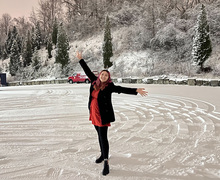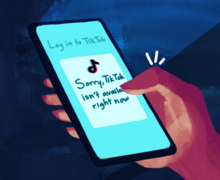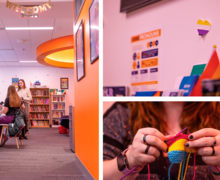Unfolding memories: SU community continues to support Japan 1 year after earthquake, tsunami strike
For the one-year anniversary of the Japan earthquake and tsunami, the Japanese Student Association is placing more than 1,000 paper cranes around campus. The Hall of Languages is also being lit up with red and white lights to symbolize the Japanese flag.
For weeks, Noriko Tomita worried from the safety of her Syracuse home.
She read updates on the earthquake and tsunami that shook Japan. She watched as the disaster destroyed her hometown of Sendai. She made call after call to friends and family who never picked up.
Villages were washed away. Train lines were shut down. The threat of nuclear radiation loomed.
‘I could not sleep well for a couple of weeks because sights of the tsunami and damaged town in Japan teared my heart,’ said Tomita, a visiting research associate from Tohoku University.
A year later, the Japanese Student Association is bringing together the Syracuse University community to remember those affected by the March 11 disasters and to celebrate the progress of Japan’s reconstruction efforts.
The 9.0-magnitude earthquake struck on March 11, 2011, at 2:46 p.m. The tsunami followed only 33 minutes later. The tragedy that devastated Japan’s northeastern coast killed almost 20,000 people.
For students like Zeo Imai, the earthquake and tsunami had lasting effects.
Imai, a graduate accounting student, was home in Tokyo when the earthquake struck. Although he had faced them before – Tokyo is home to more than 1,500 a year – the March 11 earthquake was the largest he had ever experienced.
Now he keeps an emergency kit at home, stocked with necessities such as water.
‘I’m going to remember this for a long time,’ Imai said. ‘I’m not going to be able to react to any smaller earthquakes.’
***
Paper cranes symbolize well-being, happiness and health. One thousand paper cranes grant one wish, said Midori Shiroyama, the JSA president.
In an effort to make that one wish come true, she said, the JSA folded 1,000 paper cranes with the help of the SU community.
Their wish: for the people of Japan to get well.
The paper cranes, which are arranged to form a Japanese flag, will be displayed at Huntington Beard Crouse Hall on March 23 and at E.S. Bird Library on March 26. In May, the JSA will send the flag to the Consulate General of Japan in New York, Shiroyama said.
Reminders of Japan will be prominent on campus in remembrance of the one-year mark of the disasters.
The Hall of Languages will be lit up in red and white from Monday to Friday to symbolize the colors of the Japanese flag, Shiroyama said.
A majestic paper crane that measures 3 meters high by 5 meters wide will rest in front of the building, on the field between the S.I. Newhouse School of Public Communications and the Schine Student Center.
Shiroyama said it took all nine JSA board members, 54 sheets of large white paper and five hours to fold the crane – but it was worth the time and effort.
The Japanese community has developed a stronger presence on campus since the earthquake and tsunami, Shiroyama said.
‘It was kind of surprising for me to see students’ reactions to Japan,’ she said.
Before the March 11 disasters, most students didn’t know the JSA existed. Others were unaware there was a Japanese community on campus. But the group’s efforts to raise money and awareness for the earthquake and tsunami helped to increase its presence.
Last year, the JSA sent more than $8,000 to the Consulate General of Japan in New York, Shiroyama said, adding that the group hopes to raise money again this year.
The on-campus presence the JSA has so far maintained will help reach its goal.
Members are selling handmade pins for $3. They will host an event March 23 at HBC Room 323, where participants can buy onigiri, or Japanese rice balls, for $2. The paper crane project already raised about $50.
At the end of the semester, the JSA will send the donations to the Consulate General of Japan once again, Shiroyama said.
***
As with most disasters, interest in the March 11 tragedy has waned in the last year. Only recently has Tomoko Walter seen extensive coverage of the earthquake and tsunami, prompted by the one-year mark of the disasters.
But Walter, a Japanese language professor in the College of Arts and Sciences, remembers when it was all anyone could talk about.
After the earthquake and tsunami, Walter received emails from students who had long graduated. She received phone calls from friends she hadn’t heard from in years. Students asked her personal questions in class.
Is your family OK? How are you? Did anyone get hurt?
Only a year ago, people shared a common worry about the state of Japan and those who were affected. But the earthquake and tsunami, despite the damage they caused, are no longer pressing topics of discussion.
‘I think we should not forget what happened,’ Walter said. ‘But at the same time, we have to keep looking forward.’
shkim11@syr.edu
Published on March 19, 2012 at 12:00 pm





